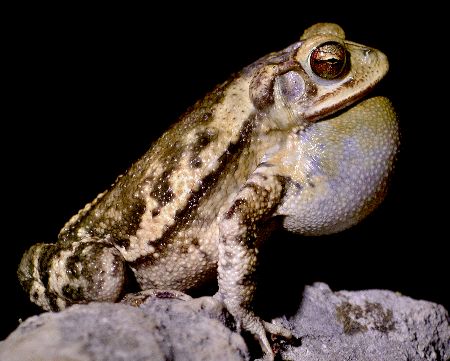by Valerie
January, 2014Gulf Coast Toad
Our hot, dry climate is not ideal for many amphibians, but one is a familiar sight in gardens. The Gulf coast toad (Bufo nebulifer) is a wonderfully adapted animal in both biology and behavior. Females can get pretty large and the biggest often take over prime retreats, like the holes in which our city water valves are found. The toads live around any backyard water source and can breed in very small ponds. Depending on rainfall, toads usually start singing at the end of April, and by May are well into the breeding mood. Males do the singing (see above) and their call is a loud, long trill. They will choose the largest expanse of open water that they can find, as it helps amplify their sound, and it is each male's goal to be the biggest and loudest! The larger the animal, the deeper his tone. Females that show up at the pond are immediately grasped by the most aggressive male and he fertilizes her eggs as she swims about laying them. Sometimes two or more males grab the same female, and the overbearing weight of them occasionally drowns her. The eggs are a long, single strand that is wound all about the vegetation in the pond. If viewed up close on the morning after being laid, the first cell divisions of the eggs are clearly visible. By the next morning, the eggs will have hatched, and the fetus-like tadpoles just hang on the remains of the strands of jelly that surrounded them. By the next day, they can swim, although they are still quite feeble. Just as the eggs hatch remarkably fast, the tadpoles grow quickly, which is probably an adaptation to the ephemeral quality of many water sources around here. However, unlike the also commonplace leopard frog, they don't get very big. If the water source is deep and constant, the toad tadpoles might remain in it all summer, staying the same size but not developing legs. But if the water starts to dry out, they quickly grow legs and lose their tails. They're able to leave the water in only a few weeks. Creek beds and water retention ponds that dry out in a month are sometimes covered with thousands of baby toads hopping about. Once they are out of the water, the tiny toads must still find damp places to survive. Toads are voracious predators and can sometimes be seen around outside lights at night, eating insects that are attracted. They have glands on the skin that make them distasteful, but they are sometimes eaten by snakes. (I watched a hognose snake manage to swallow one, in spite of the puffed up state of the prey.) The scientific name of the Gulf coast toad has undergone some changes. It used to be Bufo valliceps valliceps, which was a subspecies of a very wide-ranging animal. More recently it was determined that Bufo valliceps of Central America is actually a different species than that found in the U.S., so the name of our resident was changed to B. nebulifer. I've also seen Incilius substituted for Bufo but can't find documentation supporting that change, so I'm sticking with the more commonly accepted genus for now. |